The oldest plane tree in the world. The most ancient trees on earth
Another notch for memory. Is everything presented honestly and objectively in the official history?
Most of our forests are young. They are between a quarter and a third of their lives. Apparently, in the 19th century certain events occurred that led to the almost total destruction of our forests. Our forests keep big secrets...
It was a wary attitude towards Alexei Kungurov’s statements about Perm forests and clearings at one of his conferences that prompted me to conduct this research. Well, of course! There was a mysterious hint of hundreds of kilometers of clearings in the forests and their age. I personally was hooked by the fact that I walk through the forest quite often and quite far, but I didn’t notice anything unusual.
And this time the amazing feeling was repeated - the more you understand, the more new questions appear. I had to re-read a lot of sources, from materials on forestry of the 19th century to modern “ Instructions for carrying out forest management in the Russian forest fund" This did not add clarity, rather the opposite. But there was confidence that things are dirty here.
First amazing fact, which was confirmed - dimension quarterly network. By definition, a quarterly network is “ A system of forest blocks created on forest lands for the purpose of inventorying the forest fund, organizing and maintaining forestry and forest management».
The quarterly network consists of quarterly clearings. This is a straight strip cleared of trees and shrubs (usually up to 4 m wide), laid in the forest to mark the boundaries of forest blocks. During forest management, quarterly clearings are cut and cleared to a width of 0.5 m, and their expansion to 4 m is carried out in subsequent years by forestry workers.
Fig.2
In the picture you can see what these clearings look like in Udmurtia. The picture was taken from the Google Earth program ( see Fig.2). The blocks are rectangular in shape. For measurement accuracy, a segment of 5 blocks wide is marked. It was 5340 m, which means that the width of 1 block is 1067 meters, or exactly 1 way mile. The quality of the picture leaves much to be desired, but I myself walk along these clearings all the time, and what you see from above I know well from the ground. Until that moment, I was firmly convinced that all these forest roads were the work of Soviet foresters. But why the hell did they need to mark out the neighborhood network? in versts?
I checked. The instructions state that blocks should be 1 by 2 km in size. The error at this distance is allowed no more than 20 meters. But 20 is not 340. However, all forest management documents stipulate that if block network projects already exist, then you should simply link to them. This is understandable; the work of laying clearings is a lot of work to redo.
Fig.3
Today there are already machines for cutting down glades (see. Fig.3), but we should forget about them, since almost the entire forest fund of the European part of Russia, plus part of the forest beyond the Urals, approximately to Tyumen, is divided into a verst block network. There are also kilometer-long ones, of course, because in the last century foresters have also been doing something, but mostly it’s the mile-long one. In particular, in Udmurtia there are no kilometer-long clearings. This means that the design and practical construction of a block network in most of the forest areas of the European part of Russia were completed no later than 1918. It was at this time that the metric system of measures was adopted for mandatory use in Russia, and the mile gave way to the kilometer.
It turns out made with axes and jigsaws, if we, of course, correctly understand historical reality. Considering that the forest area of the European part of Russia is about 200 million hectares, this is titanic work. Calculations show that the total length of the clearings is about 3 million km. For clarity, imagine the first lumberjack, armed with a saw or an ax. In a day he will be able to clear on average no more than 10 meters of clearing. But we must not forget that this work can be carried out mainly in winter. This means that even 20,000 lumberjacks, working annually, would create our excellent verst quarter network for at least 80 years.
But there has never been such a number of workers involved in forest management. Based on articles from the 19th century, it is clear that there were always very few forestry specialists, and the funds allocated for these purposes could not cover such expenses. Even if we imagine that for this purpose peasants were driven from surrounding villages to do free work, it is still unclear who did this in the sparsely populated areas of the Perm, Kirov, and Vologda regions.
After this fact, it is no longer so surprising that the entire quarterly network is tilted by about 10 degrees and is directed not towards the geographic north pole, but, apparently, towards the magnetic one ( The markings were carried out using a compass, not a GPS navigator), which should have been located approximately 1000 kilometers towards Kamchatka at that time. And it’s not so confusing that the magnetic pole, according to official data from scientists, has never been there from the 17th century to the present day. It’s no longer scary that even today the compass needle points in approximately the same direction in which the quarterly network was made before 1918. All this cannot happen anyway! All logic falls apart.
But it is there. And in order to finish off the consciousness clinging to reality, I inform you that all this equipment also needs to be serviced. According to the norms, a complete audit takes place every 20 years. If it passes at all. And during this period of time, the “forest user” must monitor the clearings. Well, if anyone was watching in Soviet times, it’s unlikely that over the past 20 years. But the clearings were not overgrown. There is a windbreak, but there are no trees in the middle of the road.
But in 20 years, a pine seed that accidentally fell to the ground, of which billions are sown annually, grows up to 8 meters in height. Not only are the clearings not overgrown, you won’t even see stumps from periodic clearings. This is all the more striking in comparison with power lines, which special teams regularly clear of overgrown bushes and trees.
Fig.4
This is what typical clearings in our forests look like. Grass, sometimes there are bushes, but no trees. There are no signs of regular maintenance (see. Fig.4 And Fig.5).
Fig.5
Second big mystery- this is the age of our forest, or the trees in this forest. In general, let's go in order. First, let's figure out how long a tree lives. Here is the corresponding table.
|
* In brackets are the height and life expectancy in particularly favorable conditions.
In different sources, the figures differ slightly, but not significantly. Pine and spruce should live up to 300...400 years under normal conditions. You begin to understand how absurd everything is only when you compare the diameter of such a tree with what we see in our forests. A 300-year-old spruce should have a trunk with a diameter of about 2 meters. Well, like in a fairy tale. The question arises: Where are all these giants? No matter how much I walk through the forest, I haven’t seen anything thicker than 80 cm. There aren’t many of them. There are individual copies (in Udmurtia - 2 pines) which reach 1.2 m, but their age is also no more than 200 years.
In general, how does the forest live? Why do trees grow or die in it?
It turns out that there is a concept of “natural forest”. This is a forest that lives its own life - it has not been cut down. He has distinguishing feature- low crown density from 10 to 40%. That is, some trees were already old and tall, but some of them fell affected by fungus or died, losing competition with their neighbors for water, soil and light. Large gaps form in the forest canopy. A lot of light begins to get there, which is very important in the forest struggle for existence, and young animals begin to actively grow. Therefore, a natural forest consists of different generations, and crown density is the main indicator of this.
But if the forest was clear-cut, then new trees grow simultaneously for a long time, the crown density is high, more than 40%. Several centuries will pass, and if the forest is not touched, then the struggle for a place in the sun will do its job. It will become natural again. Do you want to know how much natural forest there is in our country that is not affected by anything? Please, map of Russian forests (see. Fig.6).
Fig.6
Bright shades indicate forests with a high canopy density, that is, these are not “natural forests.” And these are the majority. The entire European part is indicated in rich blue. This is as indicated in the table: " Small-leaved and mixed forests. Forests with a predominance of birch, aspen, gray alder, often with an admixture coniferous trees or with individual areas of coniferous forests. Almost all of them are derivative forests, formed on the site of primary forests as a result of logging, clearing, and forest fires».
You don’t have to stop at the mountains and tundra zone; there the rarity of crowns may be due to other reasons. But the plains and middle lane covers clearly a young forest. How young? Go and check it out. It is unlikely that you will find a tree in the forest that is older than 150 years. Even a standard drill for determining the age of a tree is 36 cm long and is designed for a tree age of 130 years. How does forest science explain this? Here's what they came up with:
« Forest fires are a fairly common occurrence in most of the taiga zone. European Russia. Moreover: Forest fires in the taiga are so common that some researchers consider the taiga as many burnt areas of different ages - more precisely, many forests formed on these burnt areas. Many researchers believe that forest fires are, if not the only, then at least the main natural mechanism of forest renewal, replacing old generations of trees with young ones…»
All this is called " dynamics of random violations" That's where the dog is buried. The forest was burning, and burning almost everywhere. And this, according to experts, is the main reason for the low age of our forests. Not fungus, not bugs, not hurricanes. Our entire taiga is in burnt areas, and after a fire, what remains is the same as after clear cutting. Hence the high crown density throughout almost the entire forest zone. Of course, there are exceptions - truly untouched forests in the Angara region, on Valaam and, probably, somewhere else in the vast expanses of our vast Motherland. It's really fabulous there big trees in its entirety. And although these are small islands in the vast sea of taiga, they prove that a forest can be like that.
What is so common about forest fires that over the past 150...200 years they have burned the entire forest area of 700 million hectares? Moreover, according to scientists, in a certain checkerboard order, observing the order, and certainly at different times?
First we need to understand the scale of these events in space and time. The fact that the main age of old trees in the bulk of forests is at least 100 years old suggests that the large-scale burns that so rejuvenated our forests occurred over a period of no more than 100 years. Translating into dates, for the 19th century alone. For this 7 million hectares of forest had to be burned annually.
Even as a result of large-scale forest arson in the summer of 2010, which all experts called catastrophic in volume, burned only 2 million hectares. It turns out nothing" so ordinary"This is not the case. The last justification for such a burned-out past of our forests could be the tradition of slash-and-burn agriculture. But how, in this case, can we explain the state of the forest in places where traditionally agriculture was not developed? In particular, in Perm region? Moreover, this method of farming involves labor-intensive cultural use of limited areas of forest, and not at all the uncontrolled burning of large tracts in the hot summer season, and with the wind.
Having gone through everything possible options, we can say with confidence that the scientific concept " dynamics of random violations“is not substantiated by anything in real life, and is a myth intended to disguise the inadequate state of the current forests of Russia, and therefore the events that led to this.
We will have to admit that our forests are either beyond any norm) and constantly burned throughout the 19th century ( which in itself is inexplicable and not recorded anywhere), or burned at the same time as a result of some incident, which the scientific world vehemently denies, having no arguments other than that in official nothing like this is recorded in history.
To all this we can add that there were clearly fabulously large trees in old natural forests. It has already been said about the preserved areas of the taiga. It is worth giving an example regarding deciduous forests. The Nizhny Novgorod region and Chuvashia have a very favorable climate for deciduous trees. grows there great amount oak trees But, again, you won’t find old copies. The same 150 years, no older.
Older single copies are all the same. At the beginning of the article there is a photograph of the largest oak tree in Belarus. It grows in Belovezhskaya Pushcha (see. Fig.1). Its diameter is about 2 meters, and its age is estimated at 800 years, which, of course, is very arbitrary. Who knows, maybe he somehow survived the fires, this happens. The largest oak tree in Russia is considered to be a specimen growing in the Lipetsk region. According to conventional estimates, he is 430 years old (see. Fig.7).
Fig.7
A special theme is bog oak. This is the one that is extracted mainly from the bottom of rivers. My relatives from Chuvashia told me that they pulled out huge specimens up to 1.5 m in diameter from the bottom. And there were many of them (see Fig.8). This indicates the composition of the former oak forest, the remains of which lie at the bottom. This means that nothing prevents current oak trees from growing to such sizes. Did the “dynamics of random disturbances” in the form of thunderstorms and lightning work in some special way before? No, everything was the same. So it turns out that the current forest simply has not yet reached maturity.
Fig.8
Let's summarize what we learned from this study. There are a lot of contradictions between the reality that we see with our own eyes and the official interpretation of the relatively recent past:
There is a developed neighborhood network over a vast area, which was designed in miles and was laid no later than 1918. The length of the clearings is such that 20,000 lumberjacks, using manual labor, would take 80 years to create it. The clearings are maintained very irregularly, if at all, but they do not become overgrown.
On the other hand, according to historians and surviving articles on forestry, there was no funding of comparable scale and the required number of forestry specialists at that time. There was no way to recruit such a quantity of free labor. There was no mechanization to facilitate this work.
We need to choose: either our eyes deceive us, or the 19th century was not at all what historians tell us. In particular, there could be mechanization commensurate with the tasks described. What interesting purpose could this steam engine from the film " Siberian barber" (cm. Fig.9). Or is Mikhalkov a completely unimaginable dreamer?
Fig.9
There could also have been less labor-intensive, efficient technologies for laying and maintaining clearings, which are lost today ( some distant analogue of herbicides). It is probably stupid to say that Russia has not lost anything since 1917. Finally, it is possible that clearings were not cut, but trees were planted in blocks in areas destroyed by fire. This is not such nonsense compared to what science tells us. Although doubtful, it at least explains a lot.
Our forests are much younger than the natural lifespan of the trees themselves. This is evidenced by the official map of Russian forests and our eyes. The age of the forest is about 150 years, although pine and spruce under normal conditions grow up to 400 years and reach 2 meters in thickness. There are also separate areas of forest with trees of similar age.
According to experts, all our forests are burnt. It is fires, in their opinion, that do not give trees a chance to live to their natural age. Experts do not even allow the thought of the simultaneous destruction of vast expanses of forest, believing that such an event could not go unnoticed. In order to justify this ashes, official science adopted the theory “ dynamics of random violations" This theory suggests that forest fires that destroy ( according to some strange schedule) up to 7 million hectares of forest per year, although in 2010 even 2 million hectares, destroyed as a result of deliberate forest fires, were called a disaster.
We need to choose: either our eyes are deceiving us again, or some grandiose events of the 19th century with particular impudence were not reflected in official version our past, how did I not fit in there? nor Great Tartary, nor the Great Northern Route. Atlantis with a fallen moon and even then they didn’t fit. One-time destruction 200...400 million hectares forests are even easier to imagine and hide than the undying, 100-year-old fire proposed for consideration by science.
So what is the age-old sadness about? Belovezhskaya Pushcha? Is it not about those severe wounds of the earth that the young forest covers? After all, gigantic fires by themselves don't happen...
change from 10/06/2014 - (photos added)
Most of our forests are young. They are between a quarter and a third of their lives. Apparently, in the 19th century certain events occurred that led to the almost total destruction of our forests. Our forests keep big secrets...
It was a wary attitude towards Alexei Kungurov’s statements about Perm forests and clearings at one of his conferences that prompted me to conduct this research. Well, of course! There was a mysterious hint of hundreds of kilometers of clearings in the forests and their age. I personally was hooked by the fact that I walk through the forest quite often and quite far, but I didn’t notice anything unusual.
And this time the amazing feeling was repeated - the more you understand, the more new questions appear. I had to re-read a lot of sources, from materials on forestry of the 19th century to the modern “Instructions for carrying out forest management in the forest fund of Russia.” This did not add clarity, rather the opposite. But there was a certainty that something was fishy here.
The first surprising fact that was confirmed is the size of the quarterly network. A quarter network, by definition, is “a system of forest quarters created on forest fund lands for the purpose of inventorying the forest fund, organizing and maintaining forestry and forest management.”
The quarterly network consists of quarterly clearings. This is a straight strip cleared of trees and shrubs (usually up to 4 m wide), laid in the forest to mark the boundaries of forest blocks. During forest management, quarterly clearings are cut and cleared to a width of 0.5 m, and their expansion to 4 m is carried out in subsequent years by forestry workers.
For example, in the forests of Udmurtia, blocks have a rectangular shape, the width of 1 block is 1067 meters, or exactly 1 mile. Until that moment, I was firmly convinced that all these forest roads were the work of Soviet foresters. But why the hell did they need to mark out the quarterly network in miles?
I checked. The instructions state that blocks should be 1 by 2 km in size. The error at this distance is allowed no more than 20 meters. But 20 is not 340. However, all forest management documents stipulate that if block network projects already exist, then you should simply link to them. This is understandable; the work of laying clearings is a lot of work to redo.
Today there are already machines for cutting down glades, but we should forget about them, since almost the entire forest fund of the European part of Russia, plus part of the forest beyond the Urals, approximately to Tyumen, is divided into a mile-long block network. There are also kilometer-long ones, of course, because in the last century foresters have also been doing something, but mostly it’s the mile-long one. In particular, in Udmurtia there are no kilometer-long clearings. This means that the design and practical construction of a block network in most of the forested areas of the European part of Russia were made no later than 1918. It was at this time that the metric system of measures was adopted for mandatory use in Russia, and the mile gave way to the kilometer.
It turns out that it was done with axes and jigsaws, if we, of course, correctly understand historical reality. Considering that the forest area of the European part of Russia is about 200 million hectares, this is a titanic task. Calculations show that the total length of the clearings is about 3 million km. For clarity, imagine the first lumberjack, armed with a saw or an ax. In a day he will be able to clear on average no more than 10 meters of clearing. But we must not forget that this work can be carried out mainly in winter. This means that even 20,000 lumberjacks, working annually, would create our excellent verst quarter network for at least 80 years.
But there has never been such a number of workers involved in forest management. Based on materials from articles of the 19th century, it is clear that there were always very few forestry specialists, and the funds allocated for these purposes could not cover such expenses. Even if we imagine that for this purpose peasants were driven from surrounding villages to do free work, it is still unclear who did this in the sparsely populated areas of the Perm, Kirov, and Vologda regions.
After this fact, it is no longer so surprising that the entire neighborhood network is tilted by about 10 degrees and is directed not to the geographic north pole, but, apparently, to the magnetic one (the markings were carried out using a compass, not a GPS navigator), which should have been during this time. time to be located approximately 1000 kilometers towards Kamchatka. And it’s not so confusing that the magnetic pole, according to official data from scientists, has never been there from the 17th century to the present day. It’s no longer scary that even today the compass needle points in approximately the same direction in which the quarterly network was made before 1918. All this cannot happen anyway! All logic falls apart.
But it is there. And in order to finish off the consciousness clinging to reality, I inform you that all this equipment also needs to be serviced. According to the norms, a complete audit takes place every 20 years. If it passes at all. And during this period of time, the “forest user” must monitor the clearings. Well, if anyone was watching in Soviet times, it’s unlikely that over the past 20 years. But the clearings are not overgrown. There is a windbreak, but there are no trees in the middle of the road. But in 20 years, a pine seed that accidentally fell to the ground, of which billions are sown annually, grows up to 8 meters in height. Not only are the clearings not overgrown, you won’t even see stumps from periodic clearings. This is all the more striking in comparison with power lines, which special teams regularly clear of overgrown bushes and trees.
This is what typical clearings in our forests look like. Grass, sometimes there are bushes, but no trees. There are no signs of regular maintenance.
![]()
![]()
The second big mystery is the age of our forest, or the trees in this forest. In general, let's go in order.
First, let's figure out how long a tree lives. Here is the corresponding table.
|
Name |
Height (m) |
Duration |
Homemade plum |
||
Gray alder |
||
Common rowan. |
||
Thuja occidentalis |
||
Black alder |
||
Birch |
||
Smooth elm |
||
Fir |
||
Siberian fir |
||
Common ash. |
||
Apple tree wild |
||
Common pear |
||
Rough elm |
||
Norway spruce |
30-35 (60) |
300-400 (500) |
Common pine. |
20-40 (45) |
300-400 (600) |
Small-leaved linden |
||
Beech |
||
Cedar pine |
||
Prickly spruce |
||
Larch |
||
Larch |
||
Juniper |
||
Liarsuga |
||
Cedar pine |
||
Yew berry |
1000 (2000-4000) |
|
English oak |
* in brackets – height and life expectancy in particularly favorable conditions.
In different sources, the figures differ slightly, but not significantly. Pine and spruce should live up to 300...400 years under normal conditions. You begin to understand how absurd everything is only when you compare the diameter of such a tree with what we see in our forests. A 300-year-old spruce should have a trunk with a diameter of about 2 meters. Well, like in a fairy tale. The question arises: Where are all these giants? No matter how much I walk through the forest, I haven’t seen anything thicker than 80 cm. There aren’t many of them. There are individual specimens (in Udmurtia - 2 pines) that reach 1.2 m, but their age is also no more than 200 years.
Wheeler Peak (4011 m above sea level), New Mexico, is home to bristlecone pines, one of the longest-lived trees on Earth. The age of the oldest specimens is estimated at 4,700 years.
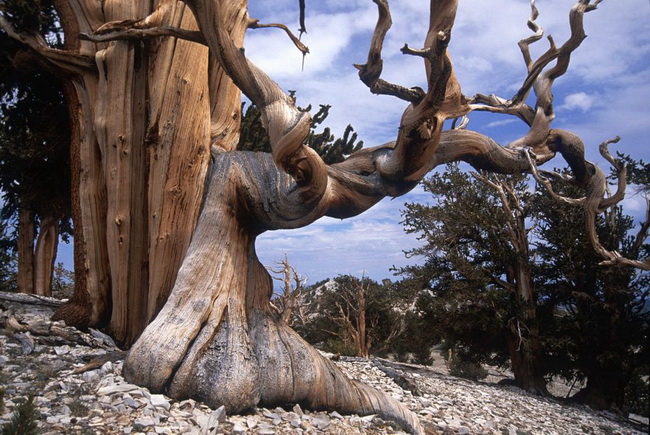
In general, how does the forest live? Why do trees grow or die in it?
It turns out that there is a concept of “natural forest”. This is a forest that lives its own life - it has not been cut down. It has a distinctive feature - low crown density from 10 to 40%. That is, some trees were already old and tall, but some of them fell affected by fungus or died, losing competition with their neighbors for water, soil and light. Large gaps form in the forest canopy. A lot of light begins to get there, which is very important in the forest struggle for existence, and young animals begin to actively grow. Therefore, a natural forest consists of different generations, and crown density is the main indicator of this.
But if the forest was clear-cut, then new trees grow simultaneously for a long time, the crown density is high, more than 40%. Several centuries will pass, and if the forest is not touched, then the struggle for a place in the sun will do its job. It will become natural again. Do you want to know how much natural forest there is in our country that is not affected by anything? Look at the map of Russian forests.
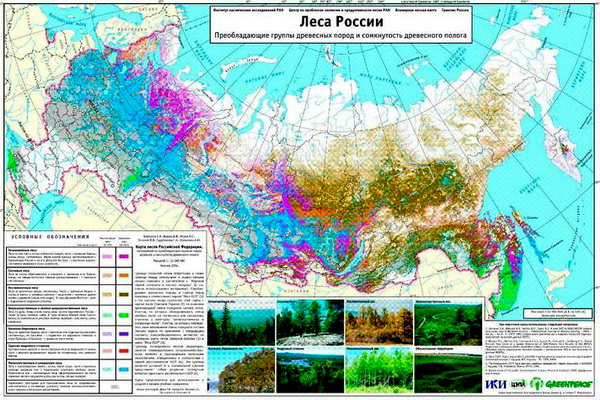
Bright shades indicate forests with a high canopy density, that is, these are not “natural forests.” And these are the majority. The entire European part is indicated in rich blue. This is, as indicated in the table: “Small-leaved and mixed forests. Forests with a predominance of birch, aspen, gray alder, often with an admixture of coniferous trees or with separate areas of coniferous forests. Almost all of them are derivative forests, formed on the site of primary forests as a result of logging, clearing, and forest fires.”
You don’t have to stop at the mountains and tundra zone; there the rarity of crowns may be due to other reasons. But the plains and middle zone are clearly covered with young forest. How young? Go and check it out. It is unlikely that you will find a tree in the forest that is older than 150 years. Even a standard drill for determining the age of a tree is 36 cm long and is designed for a tree age of 130 years. How does forest science explain this? Here's what they came up with:
“Forest fires are a fairly common phenomenon for most of the taiga zone of European Russia. Moreover: forest fires in the taiga are so common that some researchers consider the taiga as many burnt areas of different ages - more precisely, many forests formed on these burnt areas. Many researchers believe that forest fires are, if not the only, then at least the main natural mechanism for forest renewal, replacing old generations of trees with young ones..."
All this is called “dynamics of random violations.” That's where the dog is buried. The forest was burning, and burning almost everywhere. And this, according to experts, is the main reason for the low age of our forests. Not fungus, not bugs, not hurricanes. Our entire taiga is in burnt areas, and after a fire, what remains is the same as after clear cutting. Hence the high crown density throughout almost the entire forest zone. Of course, there are exceptions - truly untouched forests in the Angara region, on Valaam and, probably, somewhere else in the vast expanses of our vast Motherland. There are really fabulously large trees there in their mass. And although these are small islands in the vast sea of taiga, they prove that a forest can be like that.
What is so common about forest fires that they have 150…200 years, they burned down the entire forest area in 700 million hectares? Moreover, according to scientists, in a certain checkerboard order, observing the order, and certainly at different times?
First we need to understand the scale of these events in space and time. The fact that the main age of old trees in the bulk of forests is at least 100 years old suggests that the large-scale burns that so rejuvenated our forests occurred over a period of no more than 100 years. Translating into dates, for the 19th century alone. To do this, it was necessary to burn 7 million hectares of forest annually.
Even as a result of large-scale forest arson in the summer of 2010, which all experts called catastrophic in volume, only 2 million hectares burned. It turns out there is nothing “so ordinary” about this. The last justification for such a burned-out past of our forests could be the tradition of slash-and-burn agriculture. But how, in this case, can we explain the state of the forest in places where traditionally agriculture was not developed? In particular, in the Perm region? Moreover, this method of farming involves labor-intensive cultural use of limited areas of forest, and not at all the uncontrolled burning of large tracts in the hot summer season, and with the wind.
Having gone through all the possible options, we can say with confidence that the scientific concept of “dynamics of random disturbances” is not substantiated by anything in real life, and is a myth intended to mask the inadequate state of the current forests of Russia, and therefore the events that led to this.
We will have to admit that our forests either burned intensely (beyond any norm) and constantly throughout the 19th century (which in itself is inexplicable and not recorded anywhere), or burned at once as a result of some incident, which is why the scientific world furiously denies having no arguments, except that nothing of the kind is recorded in official history.
To all this we can add that there were clearly fabulously large trees in old natural forests. It has already been said about the preserved areas of the taiga. It is worth giving an example regarding deciduous forests. The Nizhny Novgorod region and Chuvashia have a very favorable climate for deciduous trees. There are a huge number of oak trees growing there. But, again, you won’t find old copies. The same 150 years, no older. Older single copies are all the same. Here is a photo of the largest oak tree in Belarus. It grows in Belovezhskaya Pushcha. Its diameter is about 2 meters, and its age is estimated at 800 years, which, of course, is very arbitrary. Who knows, maybe he somehow survived the fires, this happens. The largest oak tree in Russia is considered to be a specimen growing in the Lipetsk region. According to conventional estimates, he is 430 years old.

A special theme is bog oak. This is the one that is extracted mainly from the bottom of rivers. My relatives from Chuvashia told me that they pulled out huge specimens up to 1.5 m in diameter from the bottom. And there were many of them. This indicates the composition of the former oak forest, the remains of which lie at the bottom. In the Gomel region there is a river Besed, the bottom of which is dotted with bog oak, although now there are only water meadows and fields all around. This means that nothing prevents current oak trees from growing to such sizes. Did the “dynamics of random disturbances” in the form of thunderstorms and lightning work in some special way before? No, everything was the same. So it turns out that the current forest simply has not yet reached maturity.
Let's summarize what we learned from this study. There are a lot of contradictions between the reality that we see with our own eyes and the official interpretation of the relatively recent past:
– there is a developed block network over a vast area, which was designed in versts and was laid no later than 1918. The length of the clearings is such that 20,000 lumberjacks, using manual labor, would take 80 years to create it. The clearings are maintained very irregularly, if at all, but they do not become overgrown.
- on the other hand, according to historians and surviving articles on forestry, there was no funding of comparable scale and the required number of forestry specialists at that time. There was no way to recruit such a quantity of free labor. There was no mechanization to facilitate this work.
We need to choose: either our eyes deceive us, or the 19th century was not at all what historians tell us. In particular, there could be mechanization commensurate with the tasks described.
There could also have been less labor-intensive, effective technologies for laying and maintaining clearings, which have been lost today (some distant analogue of herbicides). It is probably stupid to say that Russia has not lost anything since 1917. Finally, it is possible that clearings were not cut, but trees were planted in blocks in areas destroyed by fire. This is not such nonsense compared to what science tells us. Although doubtful, it at least explains a lot.
– our forests are much younger than the natural lifespan of the trees themselves. This is evidenced by the official map of Russian forests and our eyes. The age of the forest is about 150 years, although pine and spruce under normal conditions grow up to 400 years and reach 2 meters in thickness. There are also separate areas of forest with trees of similar age.
According to experts, all our forests are burnt. It is fires, in their opinion, that do not give trees a chance to live to their natural age. Experts do not even allow the thought of the simultaneous destruction of vast expanses of forest, believing that such an event could not go unnoticed. In order to justify this ashes, official science adopted the theory of “dynamics of random disturbances.” This theory proposes that forest fires are considered a common occurrence, destroying (according to some incomprehensible schedule) up to 7 million hectares of forest per year, although in 2010 even 2 million hectares destroyed as a result of deliberate forest fires were called a disaster.
We need to choose: either our eyes are deceiving us again, or some grandiose events of the 19th century with particular impudence were not reflected in the official version of our past, just as neither the Great Tartary nor the Great Northern Route fit into it. Atlantis and the fallen moon didn’t even fit. The simultaneous destruction of 200...400 million hectares of forest is even easier to imagine and hide than the undying, 100-year fire proposed for consideration by science.
So what is the age-old sadness of Belovezhskaya Pushcha about? Is it not about those severe wounds of the earth that the young forest covers? After all, giant fires don’t happen on their own...
basis: article by A. Artemyev
photo from alexfl
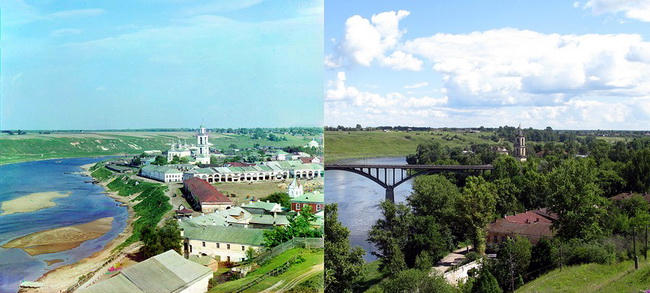
Oxbow lakes on the Volga

Torzhok
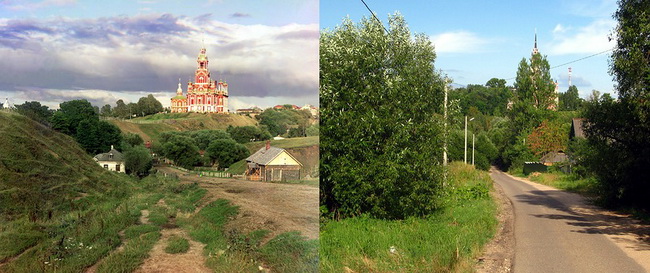
Mozhaisk
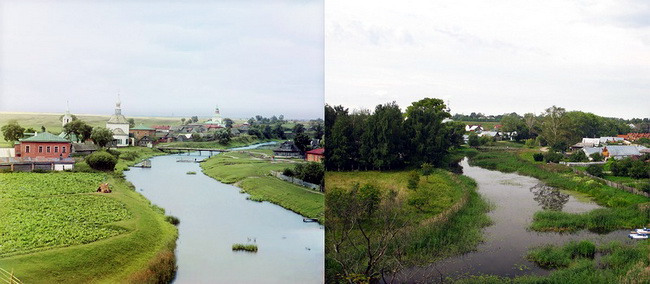
Suzdal, r. Kamenka
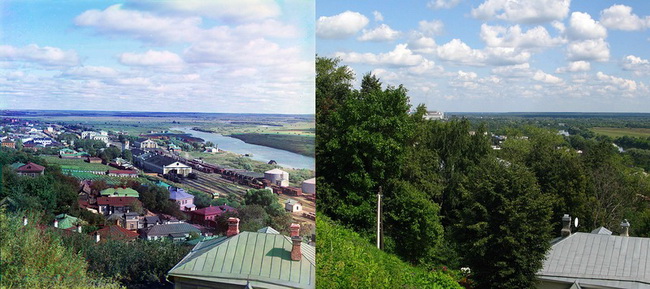
Vladimir
As surprising as it may sound, not only the city, but also the countryside landscapes are overgrown.

source of the Volga
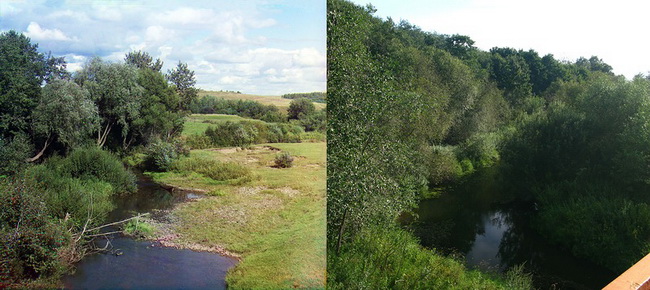
R. Koloch near Borodino
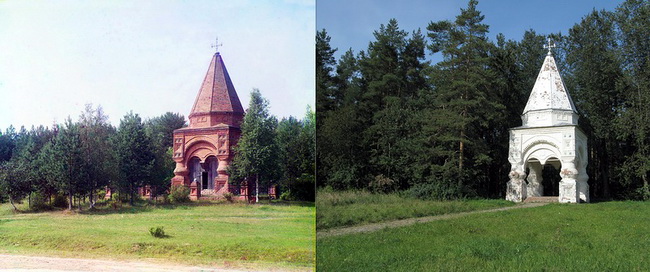
vicinity of Pereslavl-Zalessky
It’s no secret that trees live much longer than humans; it is not uncommon that their age is calculated in centuries. But few people know that there are plants that took root in the ground so long ago that even the Egyptian pyramids are younger than them, and some trees were able to observe the life of many human civilizations.
Scientists were able to determine with absolute accuracy that on our planet there are now about fifty trees that are more than a thousand years old. But if we realistically assess the situation, there may be many more such long-lived trees, because many of them grow in inaccessible and impassable corners, and it is quite difficult to analyze already discovered specimens.
The oldest tree on the planet
Officially, the oldest tree in the world is the bristlecone pine Methuselah, whose age is estimated at 5,000 years. You can see it by visiting the territory of the Inyo National Forest, which is located in eastern California (it is also called the Forest of Ancient Pines). The exact location of the oldest tree on earth is kept secret by the national forest workers in order to prevent an influx of curious people who could harm Methuselah. And since there are a lot of perennial trees in the forest, it is almost impossible to discover Methuselah on your own.
The ancient pine was discovered almost recently, in 1957, although scientists became interested in this issue long before that. Edmund Shulman, who was researching the climate of the western states of the United States and studying tree rings, by which all climate changes can be determined, came across the tree.
This type of pine has special needles; their life cycle is twenty to thirty years, so pines can save their energy by not growing new needles every now and then. Pine needles perform a vital function: regular photosynthesis gives the long-lived pine the opportunity to comfortably survive the conditions of even the harshest climate.
This is not the only oldest tree in the world, let's get to know others.

This pine tree could have broken the previous record if it had not been cut down in 1968. Upon careful examination, it turned out that the age of Prometheus exceeds 5 thousand years.
To this day, it is not clear why it was necessary to take the life of the oldest tree on earth. At that time, the research group carried out analyzes of climatic conditions ancient world. To do this, they needed to cut down several of the oldest trees to look at their tree rings. Some believe that graduate student Donald Curry, who cut down Prometheus, did not even suspect which centenarian he had raised his hand to.
How true this is is unknown, but Prometheus from Nevada is the oldest tree found so far. True, the pine received this title posthumously.
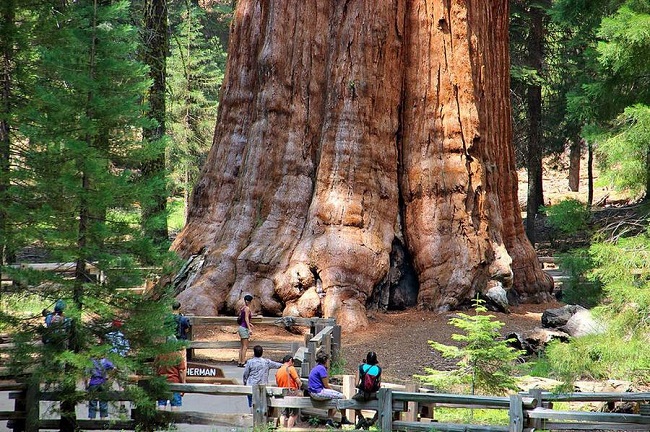
The huge sequoia General Sherman is in national park"Sequoia" in America, California. It is not only the oldest sequoia in the world, but also the tallest of all. It rises above the ground at a distance of more than 80 meters, and the circumference of its base is 30 meters. Scientists have determined the age of this tree; it is approximately 2.3-2.7 thousand years. Imagine how small and insignificant a person seems next to this giant! It is not for nothing that this giant sequoia is so attractive to tourists. According to those who have seen this tree, it looks more like a red-orange stone that has no end or edge.
By the way, this sequoia continues to grow, about one and a half centimeters are added to its circumference every year. The Americans, who love to analyze and systematize everything, hung a sign near the sequoia, which says that forty houses could be built from it, and if it were compared with a passenger train, then this tall “maiden” would win. But the point is not the amount of wood! Not every tourist imagines that this sequoia grew during the time of King Tutankhamun, but there is something to be amazed by here.
But there are other, no less amazing, oldest trees in the world.
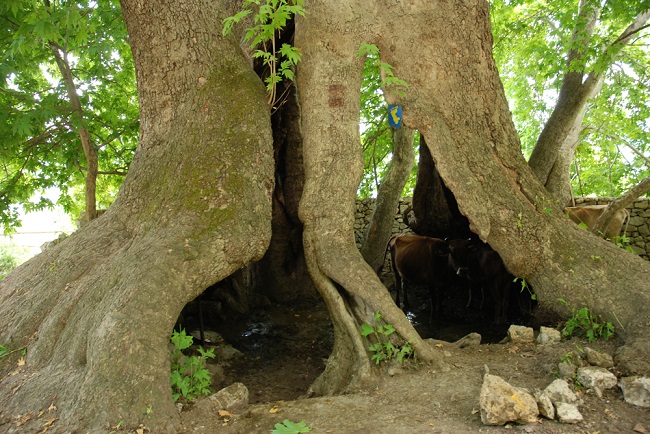
In Nagorno-Karabakh there is also a long-lived tree, whose age is about 2 thousand years. This is the Skhtorashen plane tree (plane tree) with a height of more than 50 meters and a trunk circumference of about 30 meters. The giant has an equally amazing hollow with an area of almost 50 square meters; a hundred people can easily fit into it! And the size of a plane tree “leaf” is half a meter. By the way, the Skhtorashen plane tree is perfectly visible from space, since its crown area reaches 1.5 thousand square meters. No wonder that local residents They treat the plane tree as a shrine, because for many millennia who has not rested in the shadow of this giant, even the most outstanding personalities.

Another giant grows in Abahuk, in Iran. This time it is a cypress tree, called the “Zoroastrian Sarv” and has great significance for Iranian believers. The shrine is approximately 4-5 thousand years old, approximately the same age as Stonehenge.

The centenarians of Wales, approximately 4 millennia old, Llangernew Yew, can most often be found in cemeteries. These trees are able to live such a long life thanks to the ability of the trunk to produce new branches. These branches live on and take root even when the trunk that gave them life dies.
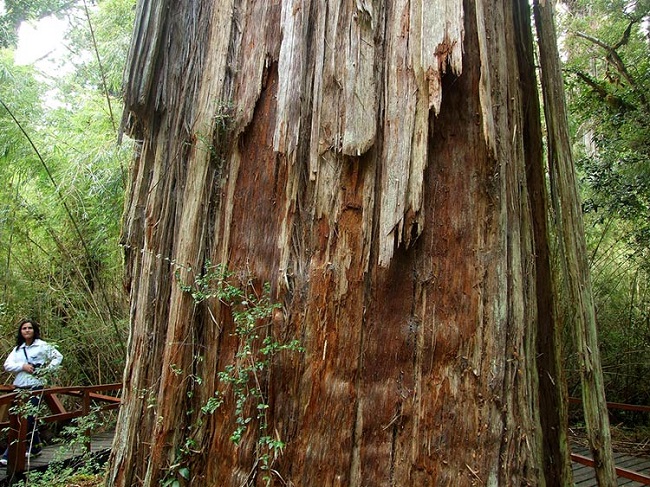
Scientists discovered the beautiful cypress back in 1933. It is located in Chile in the Andes grove. After studying its tree rings, researchers determined the age of the cypress - more than 3,500 years. Typically, such cypress trees can grow up to 50 meters in height, but just imagine that their growth per year is usually only a millimeter, how long do you need to live to reach such a height?
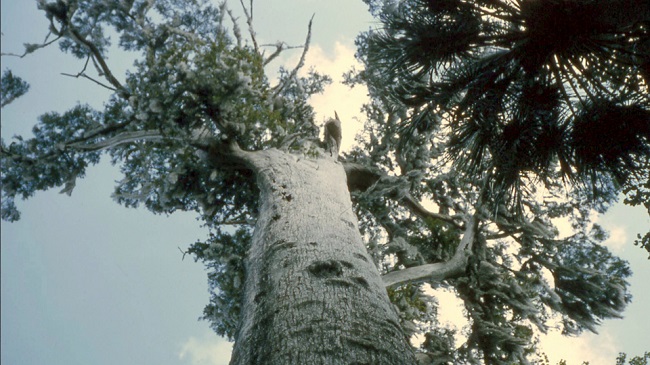
This majestic giant took root in the subtropical Big Tree Park, which is located in Florida, USA. Senator is the largest giant in the area, growing east of the Mississippi. The forty-meter cypress has a lifespan of about 3.5 thousand years, approximately the same number of years ago when the first Polynesian settlers appeared in Fiji.
The oldest trees in Russia
Our homeland, although it boasts vast expanses, unfortunately, does not have thousand-year-old trees on its territory. But there are still elders approaching this venerable age! For example, in the village of Ladushkin, in the Kaliningrad region, the Grunwald oak grows, whose age has exceeded 800 years. And the Dagestan plane tree from Russia is a little younger - it is 700 years old.
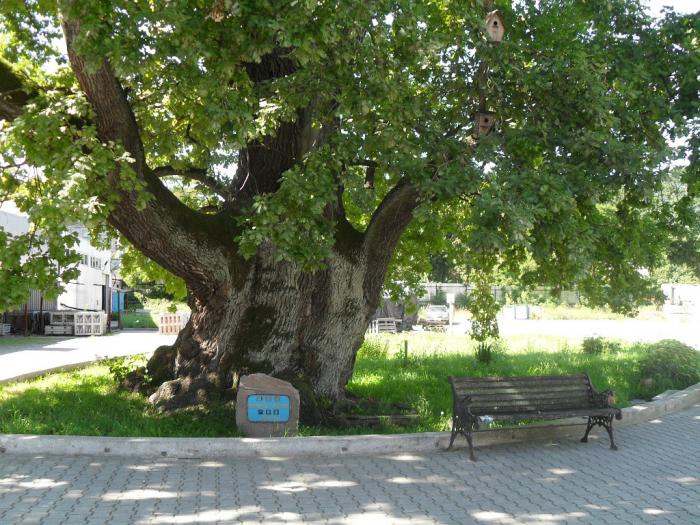
Recently, Yakutia also pleased us; botanists discovered a whole forest in it, in which many centenarians grow. Moreover, their number is simply amazing - about 15% of the entire site! These Cajander larches, which are approximately 750-885 years old, are much older than the Cajander larches from North America, which until this moment were recognized as the oldest larches on the planet.
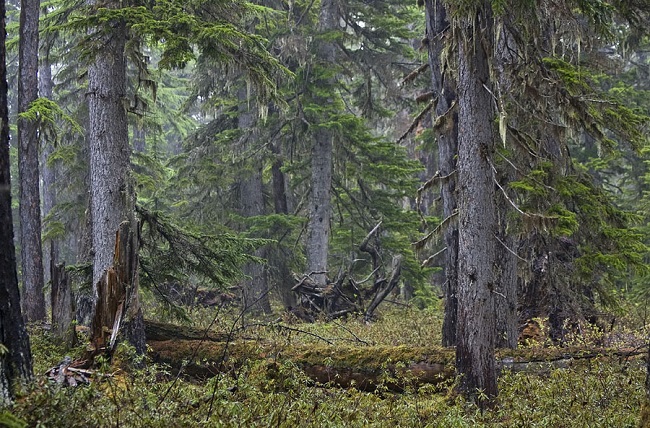
It is curious that these over-aged Yakut trees are not very large in size. Even the oldest tree in Russia cannot grow higher than nine meters and has a trunk diameter of approximately 25 centimeters. But this is natural, considering how harsh climatic conditions The Cajander larch is growing.
Trees are considered one of the longest-living organisms on our planet. The age of these amazing and majestic green plants is measured at several hundred and even thousands of years. According to official data, there are over 50 “centenarians” on earth, who are more than a thousand years old. We included in the rating oldest trees in the world that are known to science.
2000 years
- Japanese long-lived plant from the island of Yakushima. The tree has impressive dimensions, which are 25 meters in height and 16 meters in diameter. Jomon Sugi is at least 2000 years old, according to researchers.
2000 years
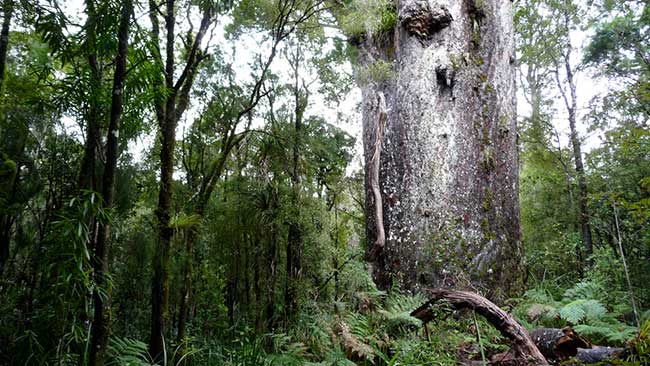
- the oldest representative of the cowrie species from New Zealand. The “Father of the Forest” with a girth of 16.5 meters in diameter has a height of 30 meters. The majestic size of this cowrie can be judged by the fact that, according to some estimates, the giant’s arboreal body would be enough to build 40 wooden houses, and the length of its trunk is more than passenger train. The approximate age of Te Matua Ngaere is estimated at 2000 years.
Due to a strong storm in 2007, the tree was seriously damaged.
2000 years

- the oldest among its representatives. Vouves grows on the island of Crete and still bears fruit, despite its age, which according to some sources is over 2000 years. Over many centuries, the ancient olive grew 12 meters in height and rounded in diameter to 3 meters. This woody plant has a very rich history and in ancient times it was considered sacred. Numerous hollows at the roots of the plant were a shelter for stray animals, and since 2000 of our century, the Vouves olive has become an attribute of the Olympics. Its branches were used to make wreaths for the winners of the Games. A museum dedicated directly to this tree was recently built.
2700 years

- another one of the green centenarians in the world, growing in the Californian US Sequoia National Park. The tree got its name in honor of the general Civil War William Tekuns. It is one of the largest growing organisms on the planet, with a height exceeding 83 meters and a trunk thickness of 31 meters. General Sherman is approximately 2,700 years old.
Hundred Horse Chestnut 2000 - 4000 years

Chestnut "Hundreds of Horses" not only one of the oldest trees in the world, but also the largest in girth. There is no exact data on the age of the oldest chestnut in the world, but according to some experts, its age averages from 2000 to 4000 years. The plant received its eccentric name because of the prevailing legend about the Queen of Aragon and her 100 knights, who were able to take refuge under the crown of a chestnut tree during a severe thunderstorm. This specimen can boast of setting a record among other representatives - it is the “thickest” tree on earth with a circumference of almost 58 meters. Thanks to this, the centenarian ended up in.
Fitzroya cypress alerche 3650 years

(Alerche) is a long-lived larch from Chile, growing in the Andes mountains. The approximate age of Alerche is estimated at 3650 years. 10 meters thick, Fitzroya reaches 70 meters in height. This type of larches is considered one of the slowest growing but longest living.
4000 years

(Llangernyw Yew) is the oldest living organism on earth, about 4000 years old. The plant is native to north Wales and is considered one of Britain's greatest trees. The longevity of this yew is explained by its ability to produce new shoots in place of dead ones. Reaching a diameter of 11 meters, this yew, due to the lack of a central part of the trunk, looks like Siamese twins.
4500 years

(Sarv-e Abarku) – natural monument Iran and one of the oldest woody plants in the world. The evergreen cypress, estimated to be 4,500 years old, is considered the oldest living thing in Asia. This cypress with its 25-meter height has grown to almost 20 meters in width.
4845 years
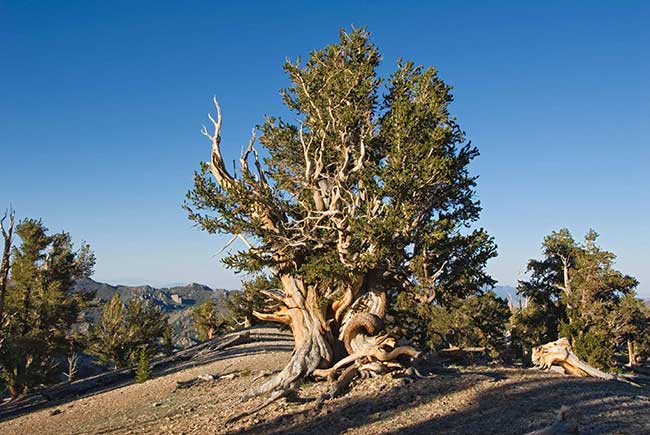
- one of ancient trees in the world. This valuable specimen grows in the Inyo National Forest in California, USA. According to experts, the age of the tree is 4845 years. The pine tree was discovered by the American scientist Edmond Shulman in 1953. In 1958, when society became aware of the centenarian, tourists from different ends Sveta. Each of the pilgrims took with them a piece of bark or a branch of Methuselah, which almost led to his death. Currently, it is difficult to say about the exact location of Methuselah, since this information is kept secret in order to protect the exhibit from vandalism.
9550 years
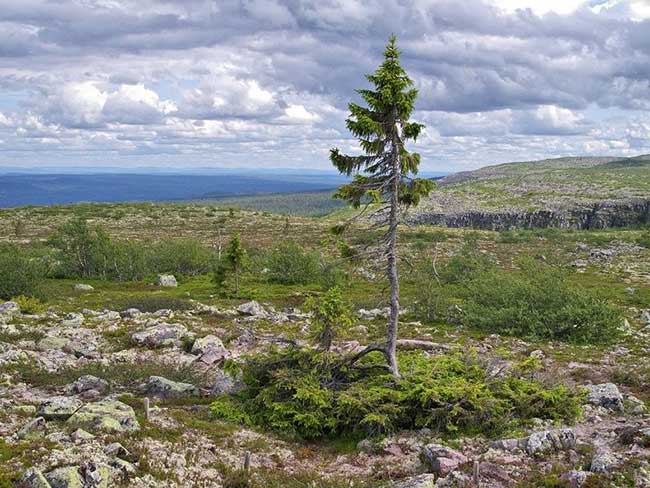
Old Tikko– spruce, which is 9550 years old, is recognized oldest tree on the ground. It grows on Mount Falufjellet in Sweden. The age of Old Tico was determined using radiocarbon dating. If the root system of spruce is thousands of years old, then the trunk is only a few hundred years old. The fact is that for thousands of years the tree was in a low-growing shrub form and could not develop in harsh conditions. Only in the 20th century did it turn into a normal tree state due to global warming, and reached a height of 5 meters. The plant was discovered by Professor Leif Kuhlman, who gave it the name Old Tico in honor of his deceased dog. Scientists explain the longevity of spruce by self-cloning - the trunk could die several times, but the root system gave life to the tree again. The current Tiko trunk is estimated to be only 600 years old, and if it dies, another new shoot may appear many years later.
There are several more ancient trees in the world that were not included in the rating, but they cannot be ignored.
These include swamp cypress Senator from USA. It was one of the ten oldest woody plants in the world until 2012, when it died in a fire. It is noteworthy that the 38-meter giant has been a landmark for Indian tribes for many generations. The cypress got its name in honor of a Missouri senator who in 1927 donated money to protect it and the surrounding lands. Almost nothing remained of the oldest giant, whose age was determined to be 3500 years.
According to some sources, the oldest living organism on earth is a clonal colony of aspen poplar, which is called “Pando”. On an area of 46 hectares, about 47 thousand aspen clones grow, having a single root system that is more than 80,000 years old! The total mass of the colony is estimated at 7 thousand tons. Therefore, it is not only the oldest clonal plant, but also the heaviest.
It is no secret that trees live several times longer than humans, and their age often exceeds several hundred years. Few people even think of the idea that there are plants that took root in the ground long before creation. Egyptian pyramids and have experienced the rise and fall of more than one human civilization.
Scientists have absolutely established that on our planet there are about fifty trees whose age exceeds a thousand years. If you really look at the situation, there are actually much more such plants, since many of them are located in hard-to-reach areas, and it is actually not easy to conduct an examination of all known specimens, taking into account their number.
The oldest tree in the world is officially considered to be the bristlecone pine Methuselah, which is about 5 thousand years old. It grows in the Inyo National Forest (also called the “Forest of Ancient Perennial Pines”), which is located in eastern California. Park employees do not disclose the exact location of the oldest plant on earth, fearing an influx of tourists, which could cause it to die. And since there are many perennial trees in this forest, it is not easy to find Mufusail.
The oldest tree in the world was discovered not so long ago, in 1957 (and the search began long before this date, since such a question simply could not help but interest scientists). It was found by Edmund Shulman, who, while studying the climate in the western states of America, paid considerable attention to the annual rings of trees, which always react extremely strongly to any changes in climatic conditions.
In order to obtain the most complete data on the climate of the region, the scientist decided to study trees (he was most interested in old plants). After some time, Shulman managed to discover bristlecone pine in the White Mountains, which was 1.5 thousand years old (it turned out that it stored information about droughts in this region much better than the previously discovered limber pine).
![]()
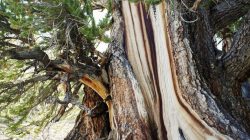

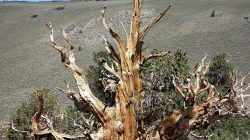
Encouraged by the discovery, Shulman devoted a significant part of his time to this plant and spent a great deal of time research work. In arid areas, on poor soil, with low humidity, in conditions under which no other tree could grow, the oldest trees on earth were discovered, the age of which was at least three thousand years. And a few years later, the oldest tree was found - Mufusail, whose age in 1957 was 4723 years!
Scientists could not help but be interested in the fact how some of the oldest plants on the planet were able to exist in such unpretentious conditions for several millennia. It turned out that these amazing creations nature managed to develop a real survival strategy.
The needles of this type of pine are long-lived: they “live” from twenty to thirty years, which is why plants do not need to frequently grow new needles, which means they manage to save energy. Needles perform an extremely important function: they provide the pine tree with stable photosynthesis, which allows it to feel comfortable in harsh climates.
If a plant is damaged by the elements, the affected areas begin to gradually die and prevent the “disease” from spreading further. As a result of this, the untouched part of the tree remains absolutely healthy - and it is able to continue its existence. The wood of bristlecone pine is dense and extremely resinous - thanks to this, it does not allow bacteria, fungi and harmful insects into the middle of the tree. ![]()
The dry air of the region in which it grows can kill more than one plant with its dryness, but in this case it prevents the wood from rotting. These trees prefer to grow in open areas, at a fairly large distance from each other, which has a beneficial effect on the needles, and they can “live” for quite a long time.
There is another advantage to this arrangement: if any plant catches fire, the fire will not spread to other pines. This type of pine is capable of standing for centuries after it dies (these trees fall only when either the rhizome begins to rot or the soil collapses).
Colonial trees
Colonial colonies of trees, which are a single living organism, are also considered the oldest plants on Earth.
The world's oldest tree colony
The most old colony on the ground (Pando Trees) is in American state Utah unites about 50 thousand aspens that have a common root system. The total age of this colony is 80 thousand years, although the age of individual trees does not exceed 130 years.
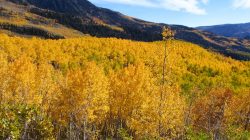
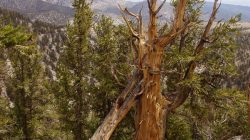
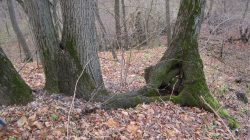
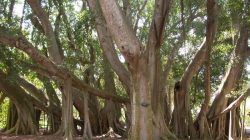
In the early 90s. last century, Pando Trees were officially recognized as the most massive living organism in the world (despite the fact that there are a great many aspens in the grove, in reality they are shoots of the main tree, which has an extensive root system).
Spruce from Sweden
Several years ago, Swedish scientists discovered a tree whose rhizomes, according to radionuclide analysis, are about 10 thousand years old, and the roots of neighboring plants turned out to be not much younger: nine and nine and a half thousand years! A spruce from Sweden called Old Tiko is the oldest clonal tree (the trunk itself is a fairly young shoot, born about six hundred years ago).
This circumstance puzzled scientists a lot, since it was believed that pine trees appeared on the territory of the Scandinavian Peninsula relatively recently.
The oldest trees
Russia, despite its vast territory, cannot boast of trees that are more than a thousand years old. There are still plants in Russia that will soon reach this age. For example, the age of one of the oldest trees in Russia, the Grunwald oak, which grows in the village of Ladushkin in the Kaliningrad region, is eight hundred years old, and the Dagestan plane tree from Russia recently turned seven hundred.
Botanists recently discovered a forest in Yakutia in which the oldest trees in Russia grow - and the number of oldest plants in this area was 15%! They turned out to be Cajander larches, whose age varies from 750 to 885 years. A species of woody plant of the pine family growing in Russia turned out to be much older than its North American relatives, whose age botanists estimate at 728 years and which, before this discovery, were considered the oldest larches on the planet. 
It is interesting that the oldest plants in Russia themselves are small - their height does not exceed nine meters, and the trunk diameter is about 25 cm (which is not surprising, given that the Cajander larch in Russia grows in extremely difficult climatic conditions, which are not conducive to plant growth) .
